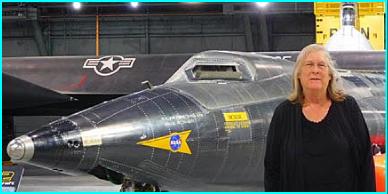 |
|||||||||||
 |
Mach 25 Media History Since Mach 25 is achieved at precisely the interface between atmospheric flight and orbital flight, it was chosen as the appropriate name for this company because of the synergy between Earth and Space. The name reflects the ideals of the company and in communicating those ideals through photography, writing, and live programs. A primary interest of mine has always been the X-15 research aircraft program, and I am well known for making presentations across the country and around the world about my book "The X-15 Rocket Plane, Flying the First Wings into Space." The Mach 25 Media logo, seen in the top left corner of every page, was designed to honor all astronauts who have flown in space and is based on a patch worn by NASA Space Shuttle astronauts. I have shown this logo to many astronauts, who have all approved of my use of the design. I am often asked about the dichotomy of spaceflight and modeling photography within my company. It may seem unusual, but this simply reflects my two primary interests. My professional modeling photography actually predates my air and space photography, as well as my writing career. It began in December 1976 with the purchase of my first Nikon F 35 mm camera. I immediately talked with a modeling agency and tried my hand at this type of work. Within a few months, I was working for the agency as their primary photographer. This development occurred while I was serving in the US Air Force. Although trained on missile electronic systems, I spent a great deal of time also photographing aircraft of all types. On several occasions, a true synergy of my two loves occurred when I was allowed to photograph fashion models alongside military aircraft. My specialty with modeling photography is to work with women who have never been in front of a camera before, or have very limited experience. I often take photos for women who never thought of being a model and just want to give it a try to see how they work with a professional photographer and if they enjoy the experience. Aircraft and spacecraft photography is obviously very different. Often very long lenses are used to capture events in the air or on a launch pad. You usually do not have a chance to retake a photo because you are recording fast moving live events as they happen. A quick trigger finger with lots of years of practice is the rule of the day. Writing about aerospace is a passion that extends back to my first stories and articles more than 40 years ago. As a member of the news media, my first assignments were to cover the first flight of the Space Shuttle (STS-1 in April 1981) and the Voyager 2 spacecraft encounter with the planet Saturn through events at the Jet Propulsion Laboratory in Pasadena, California (August 1981). These stories led to other assignments from various companies throughout nearly all robotic missions to the planets since, as well as many human missions to space, including numerous launches of the Space Shuttle from Kennedy Space Center in Florida and landings in Florida and California. I have had the privilege of reporting on and photographing nearly every type of rocket booster (operational and experimental) in the U.S. inventory (Atlas II, Atlas IIAS, Delta II, Delta Clipper Experimental [DCX & DCX-A], Lockheed Launch Vehicle [LLV], Pegasus, Space Shuttle, Taurus, Titan II, and Titan IV). Mach 25 Media is recognized as accredited news media by all major NASA centers, the U.S. military, major aerospace contractor companies, and even the Office of the Vice President. I am also skilled at presenting live programs to the public at science centers, schools, and other venues. My first program was about the X-15 research aircraft and was given at Vandenberg Air Force Base on 23 July 1987. Mach 25 Communications was officially founded in August 1993 to consolidate my many interests under one roof. The name change to Mach 25 Media took place in 2005.
What Is Mach 25? Mach 25 refers to orbital velocity. Mach 1 is the speed of sound and, in its simplest terms, the value for Mach 1 varies based on what altitude an aircraft is flying. This change in speed at altitude is related directly to the temperature at any specific altitude, so the speed of sound may vary based on exact conditions on any given day. In general, Mach 1 is approximately 760 miles per hour at Sea Level and drops to around 660 miles per hour at 50,000 feet. Mach 25 is only relevant when used in reference to air speed since a Mach number cannot be achieved in the vacuum of space. Thus Mach 25 is the velocity that a spacecraft is flying at the moment it reenters the atmosphere of Earth (entry interface). This interface occurs at approximately 75 miles (400,000 feet) when a vehicle such as the Space Shuttle orbiter has a speed of about 17,200 miles per hour. At that altitude, the speed of sound is generally around 688 miles per hour. Mach Number Chart Link
Michelle Evans Founder and President, Mach 25 Media |
|||